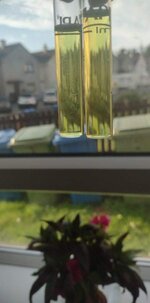Dmcx3xx
Member
I have a cycled tank. Yesterday I checked ammonia,nitrite,nitrate and pH
Ammonia was 2ppm
Nitrite 0ppm
Nitrate in the orange can't remember what one exactly
Ph in the 7s
I took everything out the tank and found a large ball of worms in the back of a hide. I put the ammonia down to this..
I done a 70% water change added prime
I have just checked again now as it's worrying me
Using API test kit these two look exactly the same at first glance one is my tap water one is tank water
When I look down into the tube it looks like ammonia is 0.25 tap water is 0ppm
What do I do next
Ammonia was 2ppm
Nitrite 0ppm
Nitrate in the orange can't remember what one exactly
Ph in the 7s
I took everything out the tank and found a large ball of worms in the back of a hide. I put the ammonia down to this..
I done a 70% water change added prime
I have just checked again now as it's worrying me
Using API test kit these two look exactly the same at first glance one is my tap water one is tank water
When I look down into the tube it looks like ammonia is 0.25 tap water is 0ppm
What do I do next



